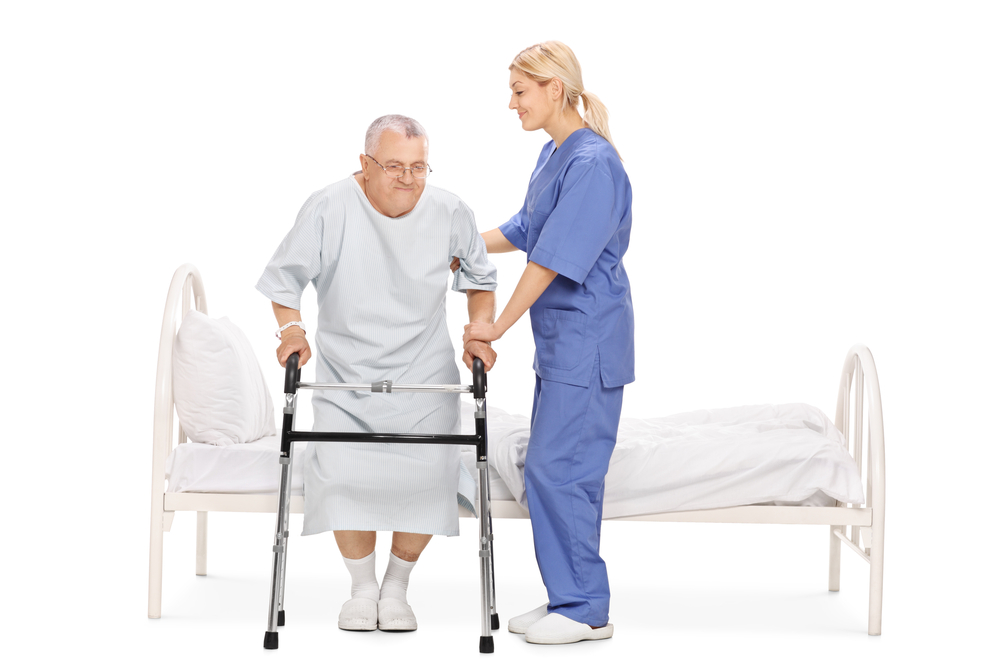Early Mobilization After a Hip or Knee Replacement on Length of Stay in an Acute Hospital
Posted on 4th May 2017 by Emma Milliken

This blog is a critical appraisal of the following review: GUERRA, M et al. (2015) Early mobilisation of patients who have had a hip or knee joint replacement reduces length of stay in hospital: a systematic review. Clinical Rehabilitation. 29(9), pp.844-854.
Introduction
An arthroplasty, or joint replacement, is a surgical procedure which aims to restore function and the integrity of a degenerative joint by either a total or partial replacement and reconstruction of the joint, using artificial prosthesis.
During my recent orthopaedic elective placement, it became clear to me that the sooner a patient was mobilised after their operation, the sooner they were discharged. Through speaking to arthroplasty patients and healthcare professionals, it was evident that the sooner the patients began to attempt to regain baseline function, their motivation levels increased as they saw results and subsequently the patients developed a goal to get home as soon as possible.
Prior research has shown benefits of early mobilisation. For example, Pearse et al. (2007) found that a group of 90 patients who were mobilised within 24 hours of surgery had an 1.0% incidence of deep vein thrombosis (DVT). In comparison, the control group who were mobilised on day 2 post surgery, had a much higher incidence of DVT, at 27.6%. This clearly suggests some benefit for the promotion of early mobilisation. However, I was interested in exploring the potential benefits on a wider scale, exploring the link to reduced length of stay in hospital. This led me to this review by Guerra et al. (2015).
About the review
The purpose of this article was to systematically review the effect of early mobilisation after hip and knee joint replacement surgery on the length of stay in hospital.
The review featured 5 randomized controlled trials, with a total of 622 participants. To qualify for inclusion, the participants must have undergone either total knee/hip arthroplasty or knee/hip unicompartmental hemiarthroplasty. The average age of participants was 63-68 years. Almost all patients had a history of osteoarthritis. Exclusion criteria included revised joint replacement surgery or hemiarthroplasties where only one surface is replaced.
4 out of 5 of the experimental groups were mobilized by either sitting out of bed or walking within 24 hours of surgery with experimental group 5 being mobilized in the same way on day 1 post op. The 5 controll groups were mobilised with the same care plan but were not mobilised at all until at least day 4 post op.
Treatment involved daily mobilisation to assist range of motion, gait patterns, balance and muscle strength. All participants received the same co-interventions and pre-operative care, such as information sessions on post discharge planning. The groups were mobilised the same number of times each day, and the only significant difference between the groups was the timing of the mobilisation.
The primary outcome measure used to assess the results was the length of stay (measured in days) required to meet discharge criteria. The secondary outcome measures used were:
- Impairment outcomes; range of
 movement (ROM), gait, balance, muscle strength
movement (ROM), gait, balance, muscle strength - Activity outcomes; Oxford knee assessment score, Visual Analogue Scale (VAS) for pain
- Health related quality of life scale
- Adverse events
- Patient satisfaction scale
Results
- The average number of days for discharge was shorter for the experimental groups, who were mobilised earlier, than for the control groups, by an average of 1.8 days.
- Range of movement, balance and gait showed gains in favour of the earlier mobilisation group. For example, experimental subjects first walked at 2.2 days post mobilisation, whereas control subjects first walked at 3.6 days post mobilisation.
- Participants required, on average, 5 fewer sessions until discharge when mobilised earlier.
- Experimental participants showed an average 11.4 degrees/3.2 degrees more flexion and extension respectively than those in the control groups.
- The likelihood of developing a DVT, wound infection or reductions in ROM increased by 17% in the control group.
- Delaying mobilisation is not only found to be detrimental to patients’ length of stay in hospital but also to patients’ health in the form of bed rest related morbidities, it was found.
Strengths and Weaknesses
This review, like all research, has some limitations. Due to the patient-centred nature of this type of rehabilitation, it would be a clinical judgement as to when the patient should first be mobilised, and this is not something which can be easily quantified. Participants also had variable numbers of hip and knee replacements in each group, with 44% of participants having knee operations and 32% having hip operations; perhaps indicating the study is more revealing about knee operation patients than hip operation patients.
However, there were strengths too. For example, to rule out bias the groups were randomly allocated. The large array of different results clearly show the positive effects of early mobilisation, leaving little room for ambiguity about the benefits of early mobilisation. There is also a strong sample size to justify the results and this review is clinically relevant to orthopaedic physiotherapists who deal with initial mobilisation decisions numerous times a day.
 Take Home Message
Take Home Message
This study has demonstrated the crucial importance of early mobilisation post knee/hip arthroplasty to ensure optimal rehabilitation potential and minimal morbidities to the patient.
By mobilising within 24 hours, it is evident that patients will most likely see an improvement in outcome measures and henceforth reach their discharge goals earlier than those who remain on bed rest for longer.
REFERENCES:
GUERRA, M et al. (2015) Early mobilisation of patients who have had a hip or knee joint replacement reduces length of stay in hospital: a systematic review. Clinical Rehabilitation. 29(9), pp.844-854. Available from: http://journals.sagepub.com/doi/abs/10.1177/0269215514558641 [Accessed 7th January 2017]
PEARSE, E O et al. (2007) Early mobilisation after conventional knee replacement may reduce the risk of postoperative venous thromboembolism. The Bone and Joint Journal [Online]. Available from: http://www.bjj.boneandjoint.org.uk/content/89-B/3/316 [Accessed 7th January 2017]



